New Design Strategies for a Reputable Restroom
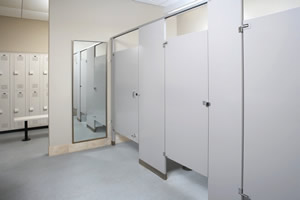
PHOTO COURTESY OF BRADLEY CORPORATION
What are your campus’ restrooms communicating to your students, educators, and visitors?
You’ve heard it before: The condition of a restroom shapes a user’s overall image of a facility or establishment. The better the restroom experience, the more positively a stakeholder sees the facility on the whole—and vice versa.
Colleges and universities are undoubtedly impacted by this restroom reputation phenomenon. In a 2015 survey by Cascades Tissue Group, 65 percent of respondents said that restrooms influenced their impression of the school they attended and 60 percent would recommend that prospective students check out a school’s restrooms before enrolling.
Another national study of public restroom perceptions revealed that college-aged Americans are significantly influenced by restroom conditions—even more than older age groups. Of respondents, 75 percent aged 18-34 say they’ve patronized certain businesses because they have cleaner restrooms, according to the 2018 Healthy Hand Washing Survey (www.bradleycorp.com/handwashing). Of all American adults, 60 percent say they make a conscious decision to choose businesses based on restroom appearances.
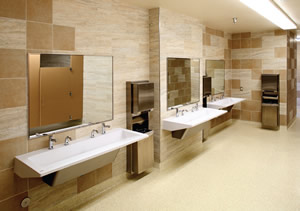
PHOTO COURTESY OF BRADLEY CORPORATION
In contrast, if a restroom is unpleasant, more than half of Millennials automatically think that the establishment is lazy or sloppy.
Clearly, stepping up restroom maintenance is essential for ensuring student, staff, and visitor satisfaction. Priorities should include regular cleaning, sanitization, and stocking; picking up debris and emptying trash cans; keeping floors, countertops, and toilet areas clean and dry; and using air fresheners.
Effective restroom maintenance is also bolstered by design strategies. High-quality furnishings, such as touchless technology, all-in-one sink designs, durable and sustainable materials, high aesthetics, and accessible washroom fixtures and accessories all reinforce a user-focused restroom environment. These newer-generation fixtures also promote benefits important to facilities such as hygiene, safety, maintainability, long life cycle, and operational efficiency.
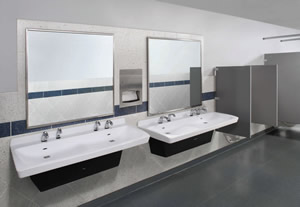
PHOTO COURTESY OF BRADLEY CORPORATION
Supporting Hand Hygiene
Restroom design and maintenance can also head off unwanted behavior, vandalism attempts—and germs. Poorly maintained restrooms may discourage students from remaining in the restroom long enough to wash hands properly, which can prevent the spread of illness in close-contact environments like educational settings. According to the Centers for Disease Control and Prevention (CDC), good hand washing practices—washing for at least 20 seconds—is the best strategy for eliminating germs from hands.
Compounding the problem of germ transmission on higher-ed campuses is less diligent hand washing practices, as those in the 18-34 age range are less likely to wash after using a public restroom, according to the Healthy Hand Washing Survey. Only 65 percent of Millennials always wash their hands compared with 82 percent of those 35-54 and 84 percent 55 and older. The most common reasons cited for not washing hands include the absence of soap or paper towels or the restroom was too unclean.
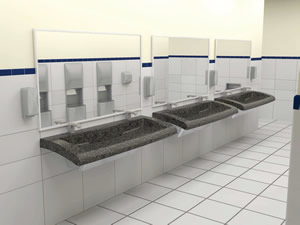
PHOTO COURTESY OF BRADLEY CORPORATION
Touch-Free Fixtures
Using sensor-operated faucets, flush valves, soap dispensers, and hand dryers reduce the incidence of touching restroom germ “hot spots” that can cause cross-contamination from users’ hands. According to Infection Control Today, 80 percent of all infectious diseases are transmitted by touch. Hands-free fixtures improve overall hygiene in the restroom and help to curb germs being carried on hands outside the restroom to other parts of the building and campus.
Using touchless fixtures also helps facilities gain compliance with the Americans with Disabilities Act (ADA). This act requires that faucets are operable with one hand, without tight gasping or twisting, and should be activated using a maximum of five pounds of force. Capacitive-sensor controlled faucets meet this requirement and minimize user frustration because the entire spout is an “omni-directional” sensor field that detects a user’s presence from any angle of approach.
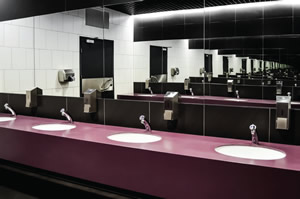
PHOTO COURTESY OF PXHERE
New-generation handwashing fixtures incorporate completely touchless all-in-one designs, providing “smart” soap, faucet, and hand dryer in one space. This integral design promotes convenience, accessibility and traffic flow—all important considerations for campus restroom spaces. All-in-one designs also keep water in the basin to eliminate water dripping on the user, walls, and floor, which can cause safety issues for users and facilities.
Touchless hand washing fixtures are also easier to maintain over time since they are not being physically handled, which increases wear and tear. Facilities can also head off vandalism attempts and wasted water, soap, and towel usage with an automatic shut off.
Conserving Paper and Water Waste
Colleges and universities use an abundance of paper and water, and paper towels account for a huge expense—costing thousands of dollars annually. High-efficiency touchless hand dryers, which can quickly dry hands in 12 or fewer seconds, eliminate paper towels that often wind up on the floor or in vandalism attempts. Hand dryers also free up staff time associated with restocking towels and trash removal.
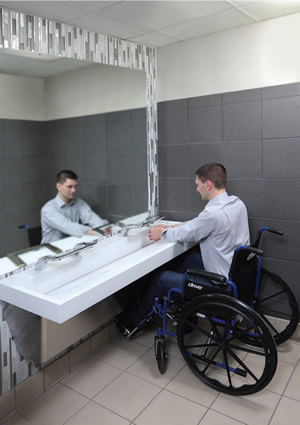
As for water, commercial buildings consume 88 percent of America’s potable water, and plumbing fixtures make up 47 percent of that figure. Analyzing plumbing fixtures’ water consumption rates and looking for ways to lower the flow is a good idea from environmental and efficiency standpoints. While a water distribution audit can help with leak-detection prioritization, older toilets and faucets may need replacing. For example, toilets with 3.5 gallons per flush (GPF) and faucets using two or more gallons per minute (GPM) could be updated with more efficient models. New technologies can reduce toilets to 1.6 GPF and faucet flow rates to .38 GPM, delivering more than 24 percent in cost reductions compared to the previous generation of low-flow faucets.
Durable and Sustainable Product Materials
Restroom products now incorporate more sustainable materials offering excellent product durability, maintainability, and life-span features in addition to environmental benefits. For fixtures such as wash basins, partitions, and lockers, materials made of natural and recycled materials are more commonly used—many of which are GREENGUARD-certified as low-emitting products.
A sustainable natural material for lavatories is a strong molded natural quartz material that can be sculpted into a range of modern design options. Composed of an eco-friendly resin and other natural materials, natural quartz is virtually maintenance-free and doesn’t require sealing or buffing. Its smooth, seamless finish has a nonporous surface, so it does not support microbial growth and is very easy to clean.
Lavatory countertops made of recycled solid surface also help ensure long-term durability and easy cleaning. Solid surface resists stains, chemicals, scratches, and heat, reducing the likelihood of repairs and the need for replacements. These lavatories also use an integrated bowl design to eliminate crevices where microbes hide.
Recycled materials are also used in solid plastic toilet partitions and lockers made from 100 percent post-consumer recycled high-density polyethylene (HDPE) solid plastic, which holds up much better in wet and humid environments than rustprone metal. Constructed from one-inch-thick solid plastic, this material stands up to heavy usage and is easy to clean.
‘Trying on’ Restroom Designs
As restroom design and product choices evolve, so do design technology resources. Architects, designers, and specifiers now have more online virtual design tools available from manufacturers that aid in planning and visualizing restroom designs using different fixtures, finishes, colors, and configurations.
In all, today’s commercial restroom design innovations enhance the cleanliness, aesthetics, and operational efficiency of campus restroom environments. For both campus facilities and its stakeholders, these design strategies also promote user satisfaction, and school loyalty and pride.
This article originally appeared in the College Planning & Management April 2018 issue of Spaces4Learning.